前言 这是一篇来自于 ACL 2022 的关于跨语言的 NER 蒸馏模型。主要的过程还是两大块:1)Teacher Model 的训练;2)从 Teacher Model 蒸馏到 Student Model。采用了类似传统的 Soft 蒸馏方式,其中利用了多任务的方式对 Teacher Model 进行训练,一个任务是 NER 训练的任务,另一个是计算句对的相似性任务。整体思路还是采用了序列标注的方法,也是一个不错的 IDEA。

论文标题:
An Unsupervised Multiple-Task and Multiple-Teacher Model for Cross-lingual Named Entity Recognition
论文链接:
https://aclanthology.org/2022.acl-long.14.pdf
模型架构
2.1 Teacher Model
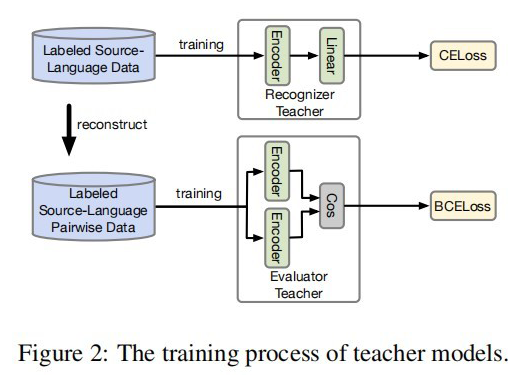



以上就是 Teacher Model 的第一个任务,直接对标注序列进行 NER,并且采用交叉熵损失函数作为 loss_function,计算如下:





2.2 Student Model Distilled
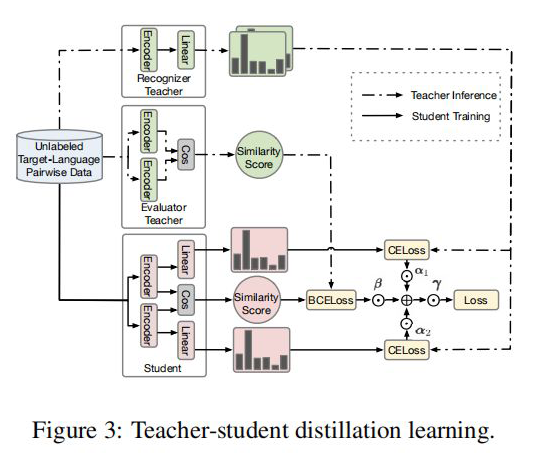


获得两个序列的hidden_state后进行一个线性计算,然后利用softmax进行归一化,得到每个Token预测的标签,计算如下:


这里也类似 Teacher Model 的计算方式,计算 target 序列间的Token相似度,计算如下所示:

当然,这里做的是蒸馏模型,所以对于输入到 Student Model 的序列对,也是Teacher Model Inference 预测模型的输入,通过 Teacher Model 的预测计算得到一个 teacher_ner_logits 和 teacher_similar_logits,将 teacher_ner_logits 分别与 和 通过 CrossEntropyLoss 来计算 TS_ _Loss 和 TS_ _Loss,teacher_similar_logits 与 通过 计算 Similar_Loss,最终将几个 loss 进行相加作为 DistilldeLoss。
这里作者还对每个 TS_ _Loss,TS_ _Loss 分别赋予了权重 ,对 Similar_Loss 赋予了权重 ,对最终的 DistilldeLoss 赋予权重 ,这样的权重赋予能够使得 Student Model 从 Teacher Model 学习到的噪声减少。最终的 Loss 计算如下所示:




这里的权重 笔者认为是用来控制 Student Model 学习倾向的参数,首先对于 来说,由于 Student Model 输入的是 Unlabeled 数据,所以在进行蒸馏学习时,需要尽可能使得 Student Model 的输出的 student_ner_logits 来对齐 Teacher Model 预测输出的 teacher_ner_logits,由于不知道输入的无标签数据的数据分布,所以设置一个权重参数来对整个 Teacher Model 的预测标签进行加权,将各个无标签的输入序列看作一个数据量较少的类别。这里可以参考 在进行数据标签不平衡时使用权重系数对各个标签进行加权的操作。而且作者也分析了, 参数是一个随着 Teacher Model 输出而递增的一个参数。如下图所示:
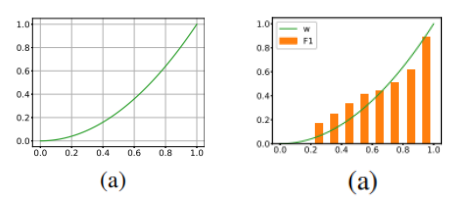



实验结果
作者分别在 CoNLL 和 WiKiAnn 数据集上进行了实验,数据使用量如下图所示:

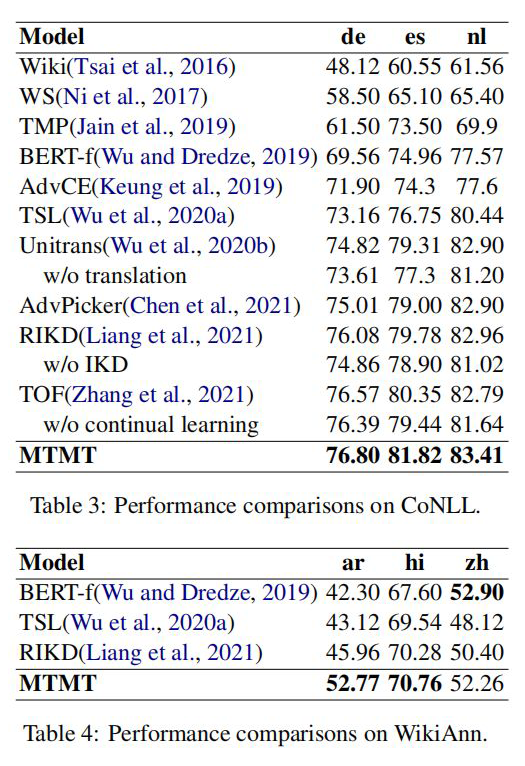
简单代码实现
#!/usr/bin/envpython
#-*-coding:utf-8-*-
#@Time:2022/5/3013:59
#@Author:SinGaln
"""
AnUnsupervisedMultiple-TaskandMultiple-TeacherModelforCross-lingualNamedEntityRecognition
"""
importtorch
importtorch.nnasnn
importtorch.nn.functionalasF
fromtransformersimportBertModel,BertPreTrainedModel,logging
logging.set_verbosity_error()
classTeacherNER(BertPreTrainedModel):
def__init__(self,config,num_labels):
"""
teacher模型是在标签数据上训练得到的,
主要分为三个encoder.
:paramconfig:
:paramnum_labels:
"""
super(TeacherNER,self).__init__(config)
self.config=config
self.num_labels=num_labels
self.mbert=BertModel(config=config)
self.fc=nn.Linear(config.hidden_size,num_labels)
defforward(self,batch_token_input_ids,batch_attention_mask,batch_token_type_ids,batch_labels,training=True,
batch_pair_input_ids=None,batch_pair_attention_mask=None,batch_pair_token_type_ids=None,
batch_t=None):
"""
:parambatch_token_input_ids:单句子token序列
:parambatch_attention_mask:单句子attention_mask
:parambatch_token_type_ids:单句子token_type_ids
:parambatch_pair_input_ids:句对token序列
:parambatch_pair_attention_mask:句对attention_mask
:parambatch_pair_token_type_ids:句对token_type_ids
"""
#RecognizerTeacher
single_output=self.mbert(input_ids=batch_token_input_ids,attention_mask=batch_attention_mask,
token_type_ids=batch_token_type_ids).last_hidden_state
single_output=F.softmax(self.fc(single_output),dim=-1)
#EvaluatorTeacher(类似双塔模型)
pair_output1=self.mbert(input_ids=batch_pair_input_ids[0],attention_mask=batch_pair_attention_mask[0],
token_type_ids=batch_pair_token_type_ids[0]).last_hidden_state
pair_output2=self.mbert(input_ids=batch_pair_input_ids[1],attention_mask=batch_pair_attention_mask[1],
token_type_ids=batch_pair_token_type_ids[1]).last_hidden_state
pair_output=torch.sigmoid(torch.cosine_similarity(pair_output1,pair_output2,dim=-1))#计算两个输出的cosine相似度
iftraining:
#计算loss,训练时采用平均loss作为模型最终的loss
loss1=F.cross_entropy(single_output.view(-1,self.num_labels),batch_labels.view(-1))
loss2=F.binary_cross_entropy(pair_output,batch_t.type(torch.float))
loss=loss1+loss2
returnsingle_output,loss
else:
returnsingle_output,pair_output
classStudentNER(BertPreTrainedModel):
def__init__(self,config,num_labels):
"""
student模型采用的也是一个双塔结构
:paramconfig:mBert的配置文件
:paramnum_labels:标签数量
"""
super(StudentNER,self).__init__(config)
self.config=config
self.num_labels=num_labels
self.mbert=BertModel(config=config)
self.fc1=nn.Linear(config.hidden_size,num_labels)
self.fc2=nn.Linear(config.hidden_size,num_labels)
defforward(self,batch_pair_input_ids,batch_pair_attention_mask,batch_pair_token_type_ids,batch_pair_labels,
teacher_logits,teacher_similar):
"""
:parambatch_pair_input_ids:句对token序列
:parambatch_pair_attention_mask:句对attention_mask
:parambatch_pair_token_type_ids:句对token_type_ids
"""
output1=self.mbert(input_ids=batch_pair_input_ids[0],attention_mask=batch_pair_attention_mask[0],
token_type_ids=batch_pair_token_type_ids[0]).last_hidden_state
output2=self.mbert(input_ids=batch_pair_input_ids[1],attention_mask=batch_pair_attention_mask[1],
token_type_ids=batch_pair_token_type_ids[1]).last_hidden_state
soft_output1,soft_output2=self.fc1(output1),self.fc2(output2)
soft_logits1,soft_logits2=F.softmax(soft_output1,dim=-1),F.softmax(soft_output2,dim=-1)
alpha1,alpha2=torch.square(torch.max(input=soft_logits1,dim=-1)[0]).mean(),torch.square(
torch.max(soft_logits2,dim=-1)[0]).mean()
output_similar=torch.sigmoid(torch.cosine_similarity(soft_output1,soft_output2,dim=-1))
soft_similar=torch.sigmoid(torch.cosine_similarity(soft_logits1,soft_logits2,dim=-1))
beta=torch.square(2*output_similar-1).mean()
gamma=1-torch.abs(soft_similar-output_similar).mean()
#计算蒸馏的loss
#teacherlogits与studentlogits1的loss
loss1=alpha1*(F.cross_entropy(soft_logits1,teacher_logits))
#teachersimilar与studentsimilar的loss
loss2=beta*(F.binary_cross_entropy(soft_similar,teacher_similar))
#teacherlogits与studentlogits2的loss
loss3=alpha2*(F.cross_entropy(soft_logits2,teacher_logits))
#finalloss
loss=gamma*(loss1+loss2+loss3).mean()
returnloss
if__name__=="__main__":
fromtransformersimportBertConfig
pretarin_path="./pytorch_mbert_model"
batch_pair1_input_ids=torch.randint(1,100,(2,128))
batch_pair1_attention_mask=torch.ones_like(batch_pair1_input_ids)
batch_pair1_token_type_ids=torch.zeros_like(batch_pair1_input_ids)
batch_labels1=torch.randint(1,10,(2,128))
batch_labels2=torch.randint(1,10,(2,128))
#t(对比两个序列标签,相同为1,不同为0)
batch_t=torch.as_tensor(batch_labels1.numpy()==batch_labels2.numpy()).float()
batch_pair2_input_ids=torch.randint(1,100,(2,128))
batch_pair2_attention_mask=torch.ones_like(batch_pair2_input_ids)
batch_pair2_token_type_ids=torch.zeros_like(batch_pair2_input_ids)
batch_all_input_ids,batch_all_attention_mask,batch_all_token_type_ids,batch_all_labels=[],[],[],[]
batch_all_labels.append(batch_labels1)
batch_all_labels.append(batch_labels2)
batch_all_input_ids.append(batch_pair1_input_ids)
batch_all_input_ids.append(batch_pair2_input_ids)
batch_all_attention_mask.append(batch_pair1_attention_mask)
batch_all_attention_mask.append(batch_pair2_attention_mask)
batch_all_token_type_ids.append(batch_pair1_token_type_ids)
batch_all_token_type_ids.append(batch_pair2_token_type_ids)
config=BertConfig.from_pretrained(pretarin_path)
#teacher模型训练
teacher_model=TeacherNER.from_pretrained(pretarin_path,config=config,num_labels=10)
outputs,loss=teacher_model(batch_token_input_ids=batch_pair1_input_ids,
batch_attention_mask=batch_pair1_attention_mask,
batch_token_type_ids=batch_pair1_token_type_ids,batch_labels=batch_labels1,
batch_pair_input_ids=batch_all_input_ids,
batch_pair_attention_mask=batch_all_attention_mask,
batch_pair_token_type_ids=batch_all_token_type_ids,
training=True,batch_t=batch_t)
#student模型蒸馏
teacher_logits,teacher_similar=teacher_model(batch_token_input_ids=batch_pair1_input_ids,
batch_attention_mask=batch_pair1_attention_mask,
batch_token_type_ids=batch_pair1_token_type_ids,
batch_labels=batch_labels1,
batch_pair_input_ids=batch_all_input_ids,
batch_pair_attention_mask=batch_all_attention_mask,
batch_pair_token_type_ids=batch_all_token_type_ids,
training=False)
student_model=StudentNER.from_pretrained(pretarin_path,config=config,num_labels=10)
loss_all=student_model(batch_pair_input_ids=batch_all_input_ids,
batch_pair_attention_mask=batch_all_attention_mask,
batch_pair_token_type_ids=batch_all_token_type_ids,
batch_pair_labels=batch_all_labels,teacher_logits=teacher_logits,
teacher_similar=teacher_similar)
print(loss_all)
笔者自己实现的一部分代码,可能不是原论文作者想表达的意思,读者有疑问的话可以一起讨论一下^~^。
审核编辑 :李倩
-
编码器
+关注
关注
45文章
3903浏览量
141397 -
模型
+关注
关注
1文章
3648浏览量
51694 -
标签
+关注
关注
0文章
153浏览量
18544
原文标题:ACL2022 | 跨语言命名实体识别:无监督多任务多教师蒸馏模型
文章出处:【微信号:zenRRan,微信公众号:深度学习自然语言处理】欢迎添加关注!文章转载请注明出处。
发布评论请先 登录
自然语言基础技术之命名实体识别相对全面的介绍
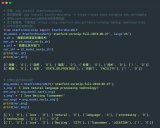
HanLP分词命名实体提取详解
基于结构化感知机的词性标注与命名实体识别框架
基于神经网络结构在命名实体识别中应用的分析与总结

深度学习:四种利用少量标注数据进行命名实体识别的方法
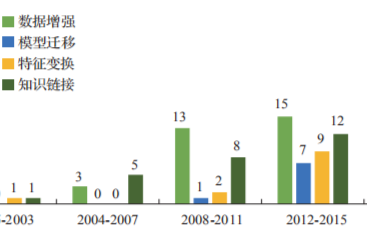
思必驰中文命名实体识别任务助力AI落地应用
新型中文旅游文本命名实体识别设计方案

知识图谱与训练模型相结合和命名实体识别的研究工作

基于字语言模型的中文命名实体识别系统






 跨语言命名实体识别:无监督多任务多教师蒸馏模型
跨语言命名实体识别:无监督多任务多教师蒸馏模型












评论